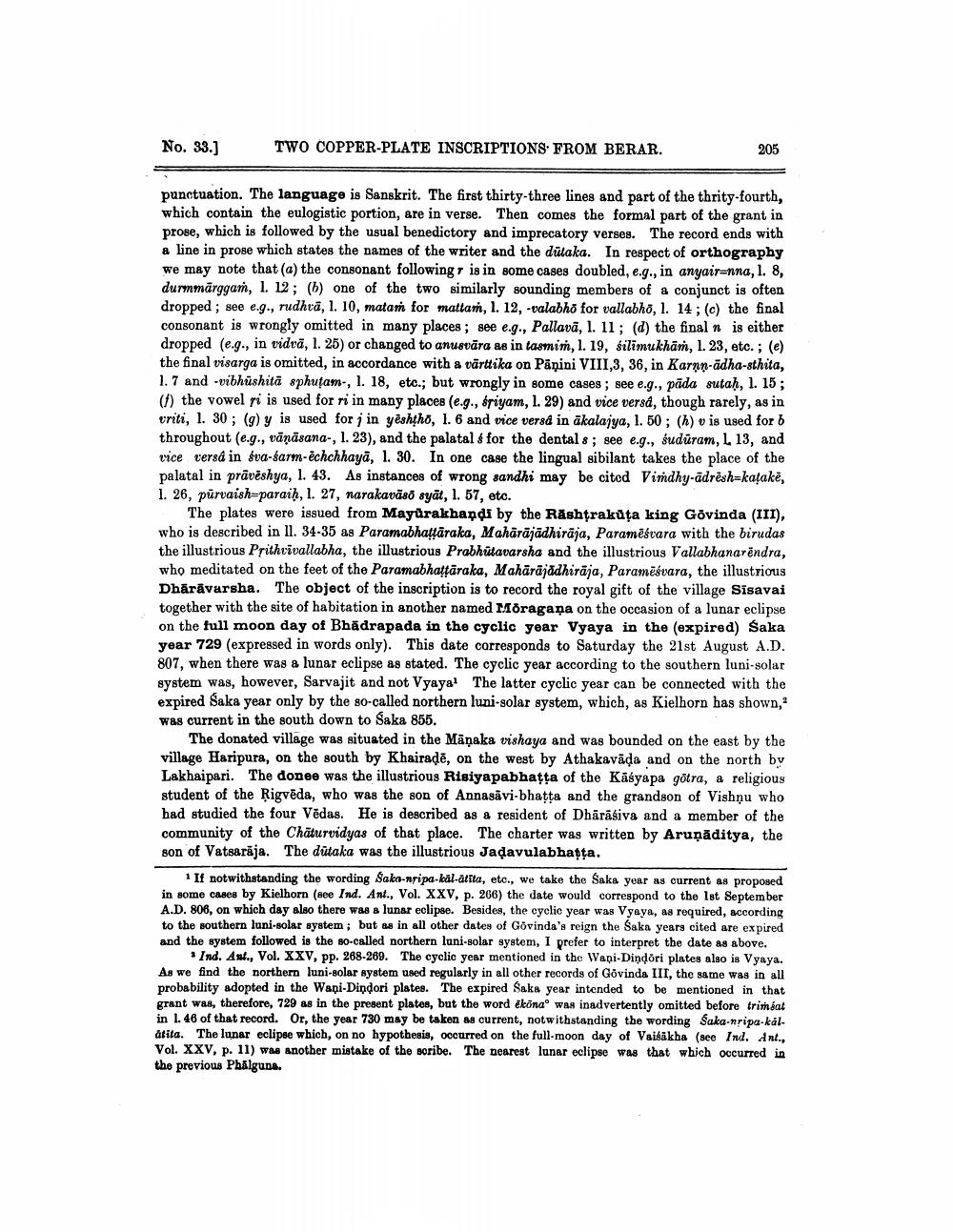________________
No. 33.]
TWO COPPER-PLATE INSCRIPTIONS FROM BERAR.
205
punctuation. The language is Sanskrit. The first thirty-three lines and part of the thrity-fourth, which contain the eulogistic portion, are in verse. Then comes the formal part of the grant in prose, which is followed by the usual benedictory and imprecatory verses. The record ends with a line in prose which states the names of the writer and the dutaka. In respect of orthography we may note that (a) the consonant following r is in some cases doubled, e.g., in anyair=nna, l. 8, durmmärggan, 1. 12; (6) one of the two similarly sounding members of a conjunct is often dropped; see e.g., rudhra, 1. 10, matar for mattam, l. 12, -valabho for vallabho, 1. 14 ; (c) the final consonant is wrongly omitted in many places; see e.g., Pallavā, 1. 11; (d) the final n is either dropped (e.g., in vidvā, 1.25) or changed to anusvāra as in tasmin, 1. 19, silimukhām, 1.23, etc. ; (e) the final visarga is omitted, in accordance with a vārttika on Pāņini VIII,3, 36, in Karnn-ādha-sthita, 1.7 and -vibhushitā sphutam., 1. 18, etc.; but wrongly in some cases; see e.g., pāda sutaḥ, l. 15; (1) the vowel ri is used for ri in many places (e.g., šsiyam, 1. 29) and vice versd, though rarely, as in eriti, 1. 30; (g) y is used for j in yėshtho, 1.6 and vice versd in ākalajya, 1. 50; (h) v is used for b throughout (e.g., vāņāsana., 1. 23), and the palatal & for the dental 8; see e.g., suduram, l. 13, and rice versa in sva-sarm-échchhayā, 1. 30. In one case the lingual sibilant takes the place of the palatal in prāvēshya, 1. 43. As instances of wrong sandhi may be cited Vindhy-ādrësh=kațakė, 1. 26, purvaish-paraih, l. 27, narakavāső syāt, 1. 57, etc.
The plates were issued from Mayurakhandi by the Rashtrakūta king Govinda (III), who is described in II. 34-35 as Paramabhatāraka, Mahārājādhiraja, Parameswara with the birudas the illustrious Prithvivallabha, the illustrious Prabhūtavarsha and the illustrious Vallabhanarendra, who meditated on the feet of the Paramabhattāraka, Mahārājadhiraja, Paramēsvara, the illustrious Dhārāvarsha. The object of the inscription is to record the royal gift of the village Sisavai together with the site of habitation in another named Moragana on the occasion of a lunar eclipse on the full moon day of Bhadrapada in the cyclic year Vyaya in the expired) Saka year 729 (expressed in words only). This date corresponds to Saturday the 21st August A.D. 807, when there was a lunar eclipse as stated. The cyclic year according to the southern luni-solar system was, however, Sarvajit and not Vyaya! The latter cyclic year can be connected with the expired Saka year only by the so-called northern luni-solar system, which, as Kielhorn has shown, was current in the south down to Saka 855.
The donated village was situated in the Māņaka vishaya and was bounded on the east by the village Haripura, on the south by Khairadē, on the west by Athakavida and on the north by Lakhaipari. The donee was the illustrious Risiyapabhatta of the Kāśyapa götra, a religious student of the Rigvēda, who was the son of Annasävi-bhatta and the grandson of Vishnu who had studied the four Vēdas. He is described as a resident of Dhārāśiva and a member of the community of the Chaturvidyas of that place. The charter was written by Aruņāditya, the son of Vatsarāja. The dutaka was the illustrious Jadavulabharta.
1 If notwithstanding the wording Sako-nripa-kal-alita, etc., we take the Saka year as current as proposed in some cases by Kielhorn (nee Ind. Ant., Vol. XXV, p. 266) the date would correspond to the lst September A.D. 806, on which day also there was a lunar eclipse. Besides, the cyclic year was Vyaya, as required, according to the southern luni-solar system ; but as in all other dates of Govinda's reign the Saka years cited are expired and the system followed is the so-called northern luni-solar system, I prefer to interpret the date as above.
Ind. Asl., Vol. XXV, pp. 268-269. The cyclic year mentioned in the Wani-Dindori plates also is Vyaya. As we find the northern luni-solar system used regularly in all other records of Govinda III, the same was in all probability adopted in the Wapi-Dindori plates. The expired Saks year intended to be mentioned in that grant was, therefore, 729 as in the present plates, but the word élona was inadvertently omitted before trimbat in 1. 46 of that record. Or, the year 730 may be taken as current, notwithstanding the wording Saka-n ripa-kalätita. The lunar eclipse which, on no hypothesis, occurred on the full-moon day of Vaisakha (ace Ind. ant., Vol. XXV. p. 11) was another mistake of the soribe. The nearest lunar eclipse was that which occurred in the previous Phålgune.




